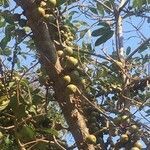A fig. It is a large tree. It grows to 24 m tall. The trunk is light grey and up to 3 m across. It can grow as a strangler from a tree branch and send down aerial roots. The leaves are smooth. They are 3-13 cm long and 3-8 cm wide. They are oblong or slightly narrow with a rounded base. There are 7-8 pairs of veins branching outwards and looping along the leaf edge. The leaves are on long leaf stalks. The fruit occur as one or two fruit high up on the spreading main branches. The fruit are 5 cm across. They have a two lobed opening at the end. They are green when young and turn red when ripe. The fruit are edible.
Leaves spirally arranged; lamina oblong to lanceolate, elliptic or ovate, 4.5–13(24) x 2–6(11.5) cm., ± coriaceous, at least the midrib beneath (and the petiole) usually drying red-brown; apex acuminate to subacute or obtuse; base rounded to subcordate or cuneate; margin entire; both surfaces glabrous; lateral veins 5–10(14) pairs; tertiary venation predominantly reticulate; petiole (0.8)2–5.5(8) cm. long, 1–2(3) mm. thick; stipules 1–15 mm. long, up to 4.5 cm. long on new flush, sparsely to densely puberulous or only ciliolate, caducous or subpersistent on new flush.
Figs 2–4 together on short, branched and finally ± cushion-shaped spurs up to c. 2(5) cm. long, or on straight, peg-like or sometimes curved spurs up to 15 cm. long, on the main or lesser branches; bud scales of the spurs densely puberulous; peduncle 12–25(50) mm. long, 2–3 mm. thick; basal bracts 3–5 mm. long, free parts caducous or sometimes subpersistent.
Receptacle subglobose, often stipitate when dry, 2–6(10) cm. in diam. when fresh, 1.5–3(6) cm. in diam. when dry, puberulous, greenish or partly purplish at maturity; wall 5–10 mm. thick when fresh, 2–4 mm. thick and ± wrinkled when dry.
Leafy twigs 2–5 mm. thick, glabrous or sparsely minutely puberulous, periderm of older parts often flaking off when dry.
Tree up to 20(40) m. tall, hemi-epiphytic and strangling or secondarily terrestrial.
